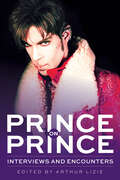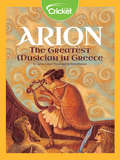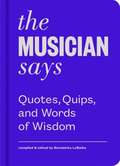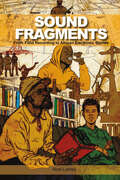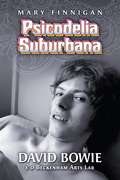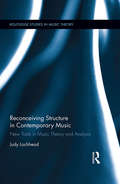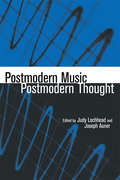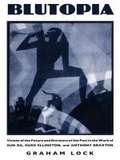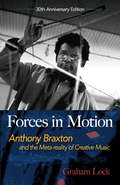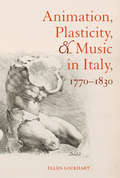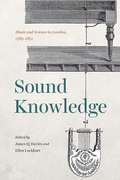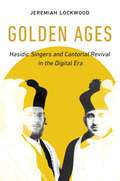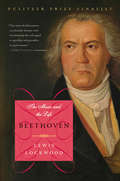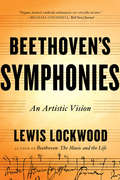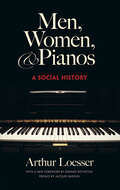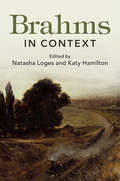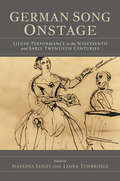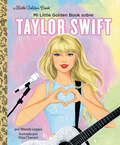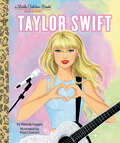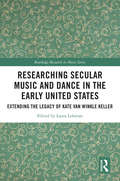- Table View
- List View
Prince on Prince: Interviews and Encounters (Musicians in Their Own Words #22)
by Arthur LiziePrince on Prince gets behind the controversies to tell the Prince story in his own words. Prince is among the most respected and influential entertainers of the twentieth century, breaking sexual, racial, and creative barriers throughout his almost forty years in the spotlight. He was a multitalented studio artist, a master songwriter who produced and performed almost all of his own music on yearly LPs and countless singles and videos. He was one of the most dynamic live performers ever to hit the stage, a world-class dancer, and musician who's still remembered for the best Super Bowl halftime performance in history. He fought for artists' rights, changed his name to a glyph, and took a star turn in the Oscar-winner Purple Rain. But for all this, he was a quiet and private individual, reluctant to talk about the work he felt should speak for itself. This volume offers a chronological look at some of Prince's most entertaining and revealing interviews, from 1978 and the release of his debut LP, For You, to a 2015 interview conducted only months before his untimely death at the age of fifty-seven. Prince's memoir was left incomplete, but this volume offers a view of the man as he sought to portray himself in his own words to journalists of every status throughout his career.
Arion: The Greatest Musician in Greece
by James LloydArion is a famous musician in ancient Greek mythology. He loves to travel across Rome and Greece to play his music. While trying to sail home, he is robbed by a group of pirates! Fearing death, he escapes by jumping into the ocean. When all hope seems lost, he meets a dolphin that might be able to help.
The Musician Says
by Benedetta LobalboThe Musician Says is an all-access backstage pass to the world of singers, songwriters, composers, and instrumentalists--all those who have a relationship with the Muse and have experienced the sacrifices, satisfactions, and frustrations it brings. You'll hear from an eclectic group that spans centuries and genres, from Mozart to Mick Jagger, Louis Armstrong to Jay Z, Dolly Parton to Lady Gaga, and many more. Paired like unlikely guests at a backstage party, this unruly crew riffs about the blessings and curses of the musician's life. This collection of intriguing and provocative quotations will remind anyone who has dreamed of playing Carnegie Hall (or maybe just mastering three chords) that the creative process bridges time and place, and that music is indeed a universal language.
Paint Your Career Green
by Michele Lobl Stan SchattA roadmap for people who want to avoid starting over or taking a severe pay cut when they change careers to become part of a growing green industry. Readers will learn about green certificate programs that offer retraining in a short timeframe.
Sound Fragments: From Field Recording to African Electronic Stories (Music / Culture)
by Noel LobleyThis book is an ethnographic study of sound archives and the processes of creative decolonization that form alternative modes of archiving and curating in the 21st century. It explores the histories and afterlives of sound collections and practices at the International Library of African Music. Sound Fragments follows what happens when a colonial sound archive is repurposed and reimagined by local artists in post-apartheid South Africa. The narrative speaks to larger issues in sound studies, curatorial practices, and the reciprocity and ethics of listening to and reclaiming culture. Sound Fragments interrogates how Xhosa arts activism contributes to an expanding notion of what a sound or cultural archive could be, and where it may resonate now and in future.
PSICODELIA SUBURBANA - David Bowie e o Beckenham Arts Lab
by Alessandra Lobo Mary FinniganEste livro não é sobre as músicas do David Bowie. Existem vários livros já escritos sobre isso. É um livro sobre uma fatia única da história, sobre quando os jovens ao Sul de Londres se uniram para uma experiência mágica cujo auge se deu na tarde de 16 de agosto. Posso escrever uma prosa razoável, mas não sou nenhuma poeta genial ou musicista. David Bowie era desde calibre. As palavras em sua canção "Memory of a Free Festival" e a melodia que segue com ela reflete bem melhor toda a atmosfera daquele dia do que qualquer tentativa que eu faça.
Reconceiving Structure in Contemporary Music: New Tools in Music Theory and Analysis (Routledge Studies in Music Theory)
by Judy LochheadThis book studies recent music in the western classical tradition, offering a critique of current analytical/theoretical approaches and proposing alternatives. The critique addresses the present fringe status of recent music sometimes described as crossover, postmodern, post-classical, post-minimalist, etc. and demonstrates that existing descriptive languages and analytical approaches do not provide adequate tools to address this music in positive and productive terms. Existing tools and concepts were developed primarily in the mid-20th century in tandem with the high modernist compositional aesthetic, and they have changed little since then. The aesthetics of music composition, on the other hand, have been in constant transformation. Lochhead proposes new ways to conceive musical works, their structurings of musical experience and time, and the procedures and goals of analytic close reading. These tools define investigative procedures that engage the multiple perspectives of composers, performers, and listeners, and that generate conceptual modes unique to each work. In action, they rebuild a conceptual, methodological, and experiential place for recent music. These new approaches are demonstrated in analyses of four pieces: Kaija Saariaho’s Lonh (1996), Sofia Gubaidulina’s Second String Quartet (1987), Stacy Garrop’s String Quartet no.2, Demons and Angels (2004-05), and Anna Clyne’s "Choke" (2004). This book defies the prediction of classical music’s death, and will be of interest to scholars and musicians of classical music, and those interested in music theory, musicology, and aural culture.
Postmodern Music/Postmodern Thought (Studies In Contemporary Music And Culture Ser. #Vol. 4)
by Judy Lochhead Joseph AunerWhat is postmodern music and how does it differ from earlier styles, including modernist music? What roles have electronic technologies and sound production played in defining postmodern music? Has postmodern music blurred the lines between high and popular music? Addressing these and other questions, this ground-breaking collection gathers together for the first time essays on postmodernism and music written primarily by musicologists, covering a wide range of musical styles including concert music, jazz, film music, and popular music. Topics include: the importance of technology and marketing in postmodern music; the appropriation and reworking of Western music by non-Western bands; postmodern characteristics in the music of Górecki, Rochberg, Zorn, and Bolcom, as well as Björk and Wu Tang Clan; issues of music and race in such films as The Bridges of Madison County, Batman, Bullworth, and He Got Game; and comparisons of postmodern architecture to postmodern music. Also includes 20 musical examples.
Blutopia: Visions of the Future and Revisions of the Past in the Work of Sun Ra, Duke Ellington, and Anthony Braxton
by Graham LockIn Blutopia Graham Lock studies the music and thought of three pioneering twentieth-century musicians: Sun Ra, Duke Ellington, and Anthony Braxton. Providing an alternative to previous analyses of their work, Lock shows how these distinctive artists were each influenced by a common musical and spiritual heritage and participated in self-conscious efforts to create a utopian vision of the future. A century after Ellington's birth, Lock reassesses his use of music as a form of black history and compares the different approaches of Ra, a band leader who focused on the future and cosmology, and Braxton, a contemporary composer whose work creates its own elaborate mythology. Arguing that the majority of writing on black music and musicians has--even if inadvertently--incorporated racial stereotypes, he explains how each artist reacted to criticism and sought to break free of categorical confines. Drawing on social history, musicology, biography, cultural theory, and, most of all, statements by the musicians themselves, Lock writes of their influential work. Blutopia will be a welcome contribution to the literature on twentieth-century African American music and creativity. It will interest students of jazz, American music, African American studies, American culture, and cultural studies.
Forces in Motion: Anthony Braxton and the Meta-reality of Creative Music: Interviews and Tour Notes, England 1985
by Graham Lock Nick White"Absolutely essential reading." — The Wire One of modern music's towering figures, composer and multi-instrumentalist Anthony Braxton has redefined critical concepts of jazz and the wider world of creative music. The Chicago native's works range from an early piece for 100 tubas to proposed compositions for orchestras on different planets. A modern classic, Forces in Motion follows Braxton's lauded quartet on a 1985 tour of England, noting his opinions of his musical predecessors — including Charlie Parker, John Coltrane, and Karlheinz Stockhausen — as well as his thoughts on racism and poverty. For this new 30th anniversary edition, Graham Lock provides a new chapter, detailing later encounters with Braxton and the quartet; Anthony Braxton has penned a new Afterword as well. In addition to inside views of the mind of a musical visionary, this book offers an entertaining chronicle of a touring band. Braxton's subjects run the gamut from chess and hamburgers to astrology, feminism, and ancient Egypt. Above all, it offers a captivating view of the frustrations and rewards that result from an artist's dedication of his life to creative music. "This book should be required reading for anyone interested in my music," Anthony Braxton has observed. "Graham Lock writes from the perceptual plane of insight and dedication — coupled with a keen wit and a dynamic intellect. This is serious writing and thinking. I could not have been more fortunate."
Music and the Exotic from the Renaissance to Mozart
by Ralph P. LockeDuring the years 1500–1800, European performing arts reveled in a kaleidoscope of Otherness: Middle-Eastern harem women, fortune-telling Spanish 'Gypsies', Incan priests, Barbary pirates, moresca dancers, and more. In this prequel to his 2009 book Musical Exoticism, Ralph P. Locke explores how exotic locales and their inhabitants were characterized in musical genres ranging from instrumental pieces and popular songs to oratorios, ballets, and operas. Locke's study offers new insights into much-loved masterworks by composers such as Cavalli, Lully, Purcell, Rameau, Handel, Vivaldi, Gluck, and Mozart. In these works, evocations of ethnic and cultural Otherness often mingle attraction with envy or fear, and some pieces were understood at the time as commenting on conditions in Europe itself. Locke's accessible study, which includes numerous musical examples and rare illustrations, will be of interest to anyone who is intrigued by the relationship between music and cultural history and by the challenges of cross-cultural (mis)understanding.
Animation, Plasticity, and Music in Italy, 1770-1830
by Ellen LockhartThis path-breaking study of stage works in Italian musical performances reconsiders a crucial period of music history. Through an interdisciplinary examination of the statue animated by music, Ellen Lockhart deftly shows how Enlightenment ideas influenced Italian theater and music, and vice versa. As Lockhart reveals, the animated statue became a fundamental figure within aesthetic theory and musical practice during the years spanning 1770–1830. Taking as its point of departure a repertoire of Italian ballets, melodramas, and operas from this period, Animation, Plasticity, and Music in Italy traces its core ideas between science, philosophy, theories of language, itinerant performance traditions, the epistemology of sensing, and music criticism.
Sound Knowledge: Music and Science in London, 1789-1851
by Ellen Lockhart James Q. DaviesWhat does it mean to hear scientifically? What does it mean to see musically? This volume uncovers a new side to the long nineteenth century in London, a hidden history in which virtuosic musical entertainment and scientific discovery intersected in remarkable ways. Sound Knowledge examines how scientific truth was accrued by means of visual and aural experience, and, in turn, how musical knowledge was located in relation to empirical scientific practice. James Q. Davies and Ellen Lockhart gather work by leading scholars to explore a crucial sixty-year period, beginning with Charles Burney’s ambitious General History of Music, a four-volume study of music around the globe, and extending to the Great Exhibition of 1851, where musical instruments were assembled alongside the technologies of science and industry in the immense glass-encased collections of the Crystal Palace. Importantly, as the contributions show, both the power of science and the power of music relied on performance, spectacle, and experiment. Ultimately, this volume sets the stage for a new picture of modern disciplinarity, shining light on an era before the division of aural and visual knowledge.
Golden Ages: Hasidic Singers and Cantorial Revival in the Digital Era (University of California Series in Jewish History and Cultures #3)
by Jeremiah LockwoodA free ebook version of this title is available through Luminos, University of California Press’s Open Access publishing program. Visit www.luminosoa.org to learn more.Golden Ages is an ethnographic study of young singers in the contemporary Brooklyn Hasidic community who base their aesthetic explorations of the culturally intimate space of prayer on the gramophone-era cantorial golden age. Jeremiah Lockwood proposes a view of their work as a nonconforming social practice that calls upon the sounds and structures of Jewish sacred musical heritage to disrupt the aesthetics and power hierarchies of their conservative community, defying institutional authority and pushing at normative boundaries of sacred and secular. Beyond its role as a desirable art form, golden age cantorial music offers aspiring Hasidic singers a form of Jewish cultural productivity in which artistic excellence, maverick outsider status, and sacred authority are aligned.
Beethoven: The Music and the Life
by Lewis LockwoodAn authoritative work offering a fresh look at Beethoven's life, career, and milieu. "Magisterial" --New York Review of Books. This brilliant portrayal weaves Beethoven's musical and biographical stories into their historical and artistic contexts. Lewis Lockwood sketches the turbulent personal, historical, political, and cultural frameworks in which Beethoven worked and examines their effects on his music. "The result is that rarest of achievements, a profoundly humane work of scholarship that will--or at least should--appeal to specialists and generalists in equal measure" (Terry Teachout, Commentary). Finalist for the Pulitzer Prize. "Lewis Lockwood has written a biography of Beethoven in which the hours that Beethoven spent writing music--that is, his methods of working, his interest in contemporary and past composers, the development of his musical intentions and ideals, his inner musical life, in short--have been properly integrated with the external events of his career. The book is invaluable." --Charles Rosen "Lockwood writes with poetry and clarity--a rare combination. I especially enjoyed the connection that he makes between the works of Beethoven and the social and political context of their creation--we feel closer to Beethoven the man without losing our wonder at his genius." --Emanuel Ax "The magnum opus of an illustrious Beethoven scholar. From now on, we will all turn to Lockwood's Beethoven: The Music and the Life for insight and instruction." --Maynard Solomon "This is truly the Beethoven biography for the intelligent reader. Lewis Lockwood speaks in his preface of writing on Beethoven's works at 'a highly accessible descriptive level.' But he goes beyond that. His discussion of the music, based on a deep knowledge of its context and the composition processes behind it, explains, elucidates, and is not afraid to evaluate; while the biographical chapters, clearly and unfussily written, and taking full account of the newest thinking on Beethoven, align closely with the musical discussion. The result is a deeply perceptive book that comes as close as can be to presenting the man and the music as a unity."--Stanley Sadie, editor, The New Grove Dictionary of Music and Musicians "Impressive for both its scholarship and its fresh insights, this landmark work--fully accessible to the interested amateur--immediately takes its place among the essential references on this composer and his music."--Bob Goldfarb, KUSC-FM 91.5 "Lockwood writes like an angel: lucid, enthusiastic, stirring and enlightening. Beethoven has found his ablest interpreter."--Jonathan Keates, The Spectator "There is no better survey of Beethoven's compositions for a wide audience."--Michael Kimmelman, The New York Times Book Review
Beethoven's Symphonies: An Artistic Vision
by Lewis LockwoodAn exploration of the unswerving artistic vision underlying Beethoven’s symphonies, from one of the world’s leading scholars of the composer’s works. More than any other composer, Beethoven left to posterity a vast body of material that documents the early stages of almost everything he wrote. From this trove of sketchbooks, Lewis Lockwood draws us into the composer’s mind, unveiling a creative process of astonishing scope and originality. For musicians and nonmusicians alike, Beethoven’s symphonies stand at the summit of artistic achievement, loved today as they were two hundred years ago for their emotional cogency, variety, and unprecedented individuality. Beethoven labored to complete nine of them over his lifetime—a quarter of Mozart’s output and a tenth of Haydn’s—yet no musical works are more iconic, more indelibly stamped on the memory of anyone who has heard them. They are the products of an imagination that drove the composer to build out of the highest musical traditions of the past something startlingly new. Lockwood brings to bear a long career of studying the surviving sources that yield insight into Beethoven’s creative work, including concept sketches for symphonies that were never finished. From these, Lockwood offers fascinating revelations into the historical and biographical circumstances in which the symphonies were composed. In this compelling story of Beethoven’s singular ambition, Lockwood introduces readers to the symphonies as individual artworks, broadly tracing their genesis against the backdrop of political upheavals, concert life, and their relationship to his major works in other genres. From the first symphonies, written during his emerging deafness, to the monumental Ninth, Lockwood brings to life Beethoven’s lifelong passion to compose works of unsurpassed beauty.
Men, Women and Pianos: A Social History
by Arthur LoesserAs the "social anchor" in middle-class homes of the nineteenth century, the piano was simultaneously an elegant piece of drawing-room furniture, a sign of bourgeois prosperity, and a means of introducing the young to music. In this admirably balanced and leisurely account of the popular instrument, the late, internationally known concert pianist Arthur Loesser takes a "piano's-eye view" of the recent social history of Western Europe and the United States.Drawing on newspapers, music manuscripts, popular accounts, and other sources, Loesser traces the history of the piano from its predecessors, the clavichord and the harpsichord, to the modern spinet and concert grand. Chapter headings such as "Clavichords Make Weeping Easier," "The Harpsichord Grows Feet," "The More Pianos the Merrier," and "The Keyboards Go West" suggest the author's lighthearted approach to topics ranging from the piano's European origins and its introduction in the United States to the decline of piano manufacturing in the early twentieth century and the "victory of airborne music" by mid-century. A preface by historian Jacques Barzun and a new foreword by music critic Edward Rothstein enhance a volume rich in wit and knowledge -- one that will delight any reader with an interest in the piano and on Western cultural history.
Men, Women and Pianos: A Social History
by Arthur LoesserA piano's-eye view of the social and philosophical history of Western Europe and the United States from the 17th century to the 1950s, with glances forward and back.
Men, Women & Pianos
by Arthur LoesserSome of the greatest composers of history have confined some of their most precious thoughts to the piano. For a century and a half, series of pianists of outstanding nimbleness and expressive power have attracted millions of admirers to their performances. Mozart, Beethoven and Chopin, Liszt, Rubinstein and Rachmaninov, to achieve the fulfillment of their art, needed to have pianos. From where did they get them? From factories, of course. But piano factories cannot stay in business simply by making a few instruments for a few great musicians. They must sell their products annually by the hundreds, by the thousands, to all manner of persons: doctors, lawyers, merchants, government officials. What did those persons want with pianos? This book may supply some answers to this question." That is the modest raison d'être for his book given by the author in a letter to the publisher. But any reader will see at once that the proliferations in the answer to his question result in something much more important and delightful. What Mr. Loesser has written is really a piano's-eye view of the social--and sometimes the philosophical--history of Western Europe and the United States from the seventeenth century to the present, with glances both forward and back. With a keen eye for both the ridiculous and the significant detail (which turn out often to be the same thing), he traces the history of the design and manufacture of the piano, and the music written for it, from its predecessors, the clavichord and the virginal, to the latest concert grand and the modern "spinet." Long established as an internationally known concert pianist, Mr. Loesser here shows himself to be an elegant stylist and an impressively learned scholar, who has the wit to see that in a social history the role of the interior decorator may be quite as important as that of the virtuoso--and that of the ambitious parent, more important than either.
Brahms in Context (Composers in Context)
by Natasha Loges Katy HamiltonBrahms in Context offers a fresh perspective on the much-admired nineteenth-century German composer. Including thirty-nine chapters on historical, social and cultural contexts, the book brings together internationally renowned experts in music, law, science, art history and other areas, including many figures whose work is appearing in English for the first time. The essays are accessibly written, with short reading lists aimed at music students and educators. The book opens with personal topics including Brahms's Hamburg childhood, his move to Vienna, and his rich social life. It considers professional matters from finance to publishing and copyright; the musicians who shaped and transmitted his works; and the larger musical styles which influenced him. Casting the net wider, other essays embrace politics, religion, literature, philosophy, art, and science. The book closes with chapters on reception, including recordings, historical performance, his compositional legacy, and a reflection on the power of composer myths.
German Song Onstage: Lieder Performance in the Nineteenth and Early Twentieth Centuries
by Natasha Loges Laura TunbridgeA singer in an evening dress, a grand piano. A modest-sized audience, mostly well-dressed and silver-haired, equipped with translation booklets. A program consisting entirely of songs by one or two composers. This is the way of the Lieder recital these days. While it might seem that this style of performance is a long-standing tradition, German Song Onstage demonstrates that it is not. For much of the 19th century, the songs of Beethoven, Schubert, Schumann, and Brahms were heard in the home, salon, and, no less significantly, on the concert platform alongside orchestral and choral works. A dedicated program was rare, a dedicated audience even more so. The Lied was a genre with both more private and more public associations than is commonly recalled. The contributors to this volume explore a broad range of venues, singers, and audiences in distinct places and time periods—including the United States, the United Kingdom, Russia, and Germany—from the mid-19th century through the early 20th century. These historical case studies are set alongside reflections from a selection of today's leading musicians, offering insights on current Lied practices that will inform future generations of performers, scholars, and connoisseurs. Together these case studies unsettle narrow and elitist assumptions about what it meant and still means to present German song onstage by providing a transnational picture of historical Lieder performance, and opening up discussions about the relationship between history and performance today.
Mi Little Golden Book sobre Taylor Swift (Little Golden Book)
by Wendy LoggiaAyude a su pequeña o pequeño a soñar en grande con esta biografía en español sobre Taylor Swift, la artista multiplatino y ganadora del premio Grammy. Las biografías de Little Golden Book son la introducción perfecta a la no ficción para lectores jóvenes, ¡así como para fanáticos de todas las edades! "Imprescindible para cualquier colección de Taylor Swift". —Rolling Stone¡Este Little Golden Book sobre Taylor Swift, la cantante y compositora cuyo talento distintivo para contar historias la ha convertido en una de las superestrellas más famosas de la música country y pop, es tan inspirador para los niños pequeños como para sus padres Swiftie!Busca biografías Little Golden Book sobre: • Lady Gaga • Beyoncé • Dolly Parton • Elton JohnHelp your little one dream big with a Little Golden Book biography about Taylor Swift, the Grammy Award–winning and multiplatinum artist. Little Golden Book biographies are the perfect introduction to nonfiction for young readers—as well as fans of all ages!"A must-have for any Taylor Swift collection." —Rolling StoneThis Little Golden Book about Taylor Swift--the singer and songwriter whose distinctive talent for storytelling has made her one of the biggest superstars in both country and pop music--is an inspiring read-aloud for young children as well as their Swiftie parents!Look for more Little Golden Book biographies: • Lady Gaga • Beyoncé • Dolly Parton • Elton John
Taylor Swift: A Little Golden Book Biography (Little Golden Book)
by Wendy LoggiaHelp your little one dream big with a Little Golden Book biography about Taylor Swift, the Grammy Award–winning and multiplatinum artist. Little Golden Book biographies are the perfect introduction to nonfiction for preschoolers!This Little Golden Book about Taylor Swift--the singer and songwriter whose distinctive talent for storytelling has made her one of the biggest superstars in both country and pop music--is an inspiring read-aloud for young children as well as their Swiftie parents!Look for more Little Golden Book biographies: • Willie Nelson • Beyoncé • Dolly Parton • Tony Bennett
Still Alright: A Memoir
by Kenny LogginsEnjoy the stories behind Kenny Loggins' legendary five-decade career as a celebrated songwriter, chart-topping collaborator, and &“The Soundtrack King&” with this pop icon&’s intimate and entertaining music memoir. In a remarkable career, Kenny Loggins has rocked stages worldwide, released ten platinum albums, and landed hits all over the Billboard charts. His place in music history is marked by a unique gift for collaboration combined with the vision to evolve, adapt, and persevere in an industry that loves to eat its own. Loggins served as a pivotal figure in the folk-rock movement of the early &’70s when he paired with former Buffalo Springfield member Jim Messina, recruited Stevie Nicks for the classic duet &“Whenever I Call You &‘Friend,&’&” then pivoted to smooth rock in teaming up with Michael McDonald on their back-to-back Grammy-winning hits &“What a Fool Believes&” and &“This Is It&” (a seminal moment in the history of what would come to be known as yacht rock). In the &’80s, Loggins became the king of soundtracks with hit recordings for Caddyshack, Footloose, and Top Gun; and a bona fide global superstar singing alongside Bruce Springsteen and Michael Jackson on &“We Are the World.&” In Still Alright, Kenny Loggins gives fans a candid and entertaining perspective on his life and career as one of the most noteworthy musicians of the 1970s and &’80s. He provides an abundance of compelling, insightful, and terrifically amusing behind-the-scenes tales. Loggins draws readers back to the musical eras they&’ve loved, as well as addressing the challenges and obstacles of his life and work—including two marriages that ended in divorce, a difficult but motivating relationship with the older brother for which &“Danny&’s Song&” is named, struggles with his addiction to benzodiazepines, and the revelations of turning seventy and looking back at everything that has shaped his music—and coming to terms with his rock-star persona and his true self.
Researching Secular Music and Dance in the Early United States: Extending the Legacy of Kate Van Winkle Keller (Routledge Research in Music)
by Laura LohmanThis book provides a practical introduction to researching and performing early Anglo-American secular music and dance with attention to their place in society. Supporting growing interest among scholars and performers spanning numerous disciplines, this book contributes quality new scholarship to spur further research on this overshadowed period of American music and dance. Organized in three parts, the chapters offer methodological and interpretative guidance and model varied approaches to contemporary scholarship. The first part introduces important bibliographic tools and models their use in focused examinations of individual objects of material musical culture. The second part illustrates methods of situating dance and its music in early American society as relevant to scholars working in multiple disciplines. The third part examines contemporary performance of early American music and dance from three distinct perspectives ranging from ethnomusicological fieldwork and phenomenology to the theatrical stage. Dedicated to scholar Kate Van Winkle Keller, this volume builds on her legacy of foundational contributions to the study of early American secular music, dance, and society. It provides an essential resource for all those researching and performing music and dance from the revolutionary era through the early nineteenth century.
